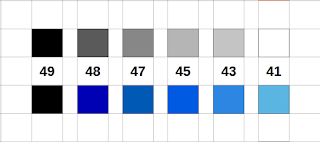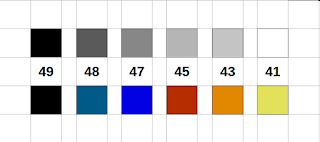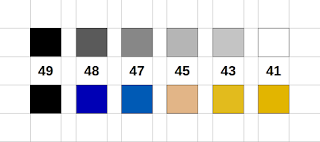Opus Pixellatum allows for an amazing range of variations and improvisations.
To illustrate this versatility, I have worked from an actual model of a mosaic portrait I have executed several times.
| Green Eyes, opus pixellatum, 6 levels Grayscale |
This model is designed on a six levels gray scale. The numbers are the references of Mosaic Art Supply "elementile 8 mm" recycled glass tiles. The mosaic once complete would measure 13 x 27". This mosaic is what you would obtain if you would scrupulously use the references printed on the model.
While the model calls for set colors, the mosaicist has all latitude to change them to fit his creativity and fantasy.
He can for example decide to change the colors from a Gray Scale to a Blue Scale.
 |
| From Gray to Blue Scale. |
This is the simplest change that the mosaicist can use.
Other modes of variations can use 2 different scales. In this combination of a Blue and an Orange Scale, the respective darknesses of colors has been respected.
 |
| Variation # 6 |
In this one, however, the progression in darkness is different for the colored scale than it is for the gray scale.
 |
| Variation # 1 |
There are many more possibilities as illustrated below.
| Green Eyes Mosaic, Variation #1 |
In the piece below, only every other tesserae are laid in accordance to the grayscale of the original model. then, the other tesserae are laid, the colors progress from Red on the Left to Blue on the Right.
| Green Eyes Mosaic, Variation #2 |
The progression of colors in Variation #3 is similar to the Variation #1, with warmer tones.
| Green Eyes mosaic, Variation #3 |
#4 has brighter colors.
| Green Eyes mosaic, Variation #4 |
On #5 based on #3, every other tile is filled with a gray color.
| Green Eyes mosaic, Variation #5 |
#6 is a different repartition of brighter colors, still Blues, Yellows and Reds
| Green Eyes mosaic, Variation #6 |
In #7 based on #5, a gradient of colors has filled up every other tile.
| Green Eyes mosaic, Variation#7 |
#8 is a brighter, more contrasted version of #7
| Green Eyes Mosaic, Variation #8 |
The filling gradient of #9 is darker than the one of #8
| Green Eyes Mosaic, Variation #9 |
# 10 uses Green tones instead of the previous Blues used in #2 to #9
| Green Eyes Mosaic, Variation #10 |
In #11 the lower veils is using reds where as the top of the image is similar to the top of #10
| Green Eyes Mosaic, Variation #11 |
A totally different type of variation consists in the superposition of two layers of different images. In the 3 following examples, I have used an opus tessellatum image on top of the Opus Pixellatum.
| Green Eyes Mosaic, Variaton #12 |
Practically, this is done by first building the opus tesselatum piece by gluing the tesserae on top of a vinyl sheet that covers the tesselatum model, once this done, the mosaicists removes the Tesselatum model and inserts the Pixellatum model under the vinyl, and resume the execution of the mosaic, following the design of the Pixellatum model.
| Green Eyes Mosaic, Variation #13 |
This may sound a little complicated, it is not really. I Plan to teach this technique during a seminar next spring.
| Green Eyes Mosaic, Variation #14 |
Opus Pixellatum allows for a formidable array of variations. Only your imagination is the limit. Several of my students have experimented and obtained amazing results with this technique (Click here for my Post on Daniel Adams).
I encourage you to give it a try.
I will email you, for free, the Gray scale Model at the top of this article.
Just contact me at frederic.lecut@mosaicblues.com
You just have it printed and get to work !
I am a French mosaicist
living in Headland, Alabama, USA.
My Art is about inspiring people.
You can see some of my work at www.mosaicblues.com
You can contact me either by phone
at (334) 798 1639 or by email at
You can also subscribe to my

I think your Opus Pixellatum is very interesting. So, are you selling it or what? I don't see a price or how to order it. Can you give me more information about this?
ReplyDeleteI create and sell mosaic models for people who want to make a mosaic from one of their pictures. Prices vary with type and size of the model. I also assist you on line to actually build the mosaic
ReplyDeleteIf you are interested, please contact me at frederic.lecut@mosaicblues.com
Thank you for your interest in this amazing and fun technique